#ma’at
Explore tagged Tumblr posts
Text

Thoth with feather of Ma’at - requested by @kulerrrr
#my art#art requests#I already drew Thoth cute so I thought I’d draw him more… different#thanks for your request!!#Thoth#thoth god#ma’at#goddess maat#ancient egypt#egyptian#egyptology#ancient history#egyptian gods#Maat feather#egyptian mythology#Egypt#digital art
38 notes
·
View notes
Text

@_africanhistory :
The Ten Commandments are a condensed version of the 42 Declarations of Ma'at from ancient Kemet, stripped of their original context and power.
#ma’at#kushite#kemetic#spirituality#science#blackout#world history#black history#ten commandments#religion
186 notes
·
View notes
Text

Lady of Justice, Dua Ma’at!
44 notes
·
View notes
Text









Lady Ma’at’s aesthetic
#fyp#fypシ#fypシ゚viral#fypage#fyppage#tumblr fyp#satanism#witchcraft#maat#ma’at#aesthetic#digital offering#egyptian deities#egyptian mythology
52 notes
·
View notes
Text
So I just realized that I never shared my senior art thesis that I had completed! I love tarot cards and studying g Egyptian mythology so I decided to illustrate some of my favorite deities with the major arcana tarot cards!
Kehpri for Chariot
Ra for Emperor,
Anubis for Death
Sutkeh/Set for The Devil
Neith for Temperance
Thoth for Magician
Isis and Osiris for The Lovers
Sekhmet for Strength
Ma’at for Justice









#my artwork#artists on tumblr#procreate illustration#my art <3#my art#digital illustration#digital painting#tarot#tarot cards#pagan#paganism#egypt#ancient egypt#egyptian mythology#Anubis#ra deity#sutekh#isis deity#Ma’at#egyptian deities
26 notes
·
View notes
Text

a garland solar crown for Ma’at
lapis, turquoise, bronze, and carnelian
14 notes
·
View notes
Text

All the Egyptian gods that I have :333
I have no idea what to put set in- they literally said “yeah you can come back to life, but you’re not coming back to life as a deity lmao you killed a man so you’re a regular ass snake now fuck you” so I don’t know what to put him in outfit wise😭
7 notes
·
View notes
Text
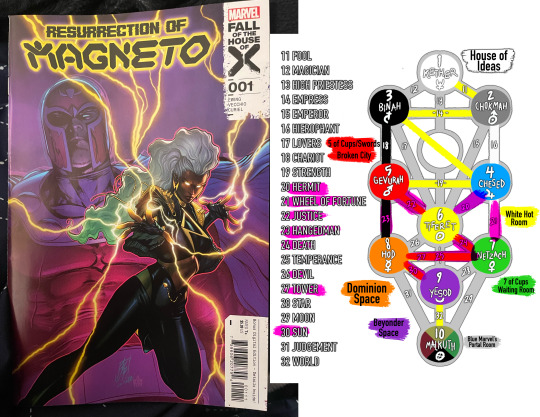
Resurrection of Magneto #1 was incredible! I’ve mapped out Storm’s journey by correlating the tarot imagery. Interestingly, she is not taking the lightning path despite her motif, instead starting at Malkuth heading to Netzach, followed by Hod and ending in Gavurah.

Magneto as the 5 of Cups in the Broken City (Gavurah)
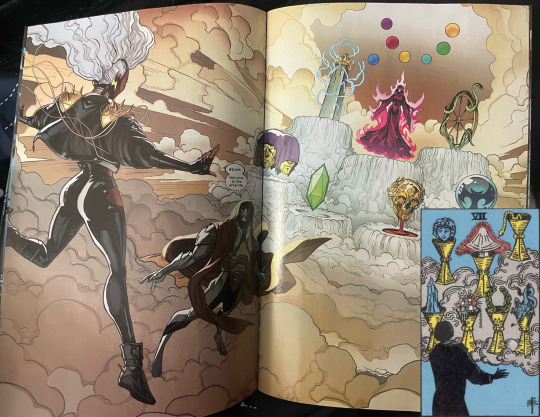
Storm as the 7 of Cups in the Waiting Room (Netzach)
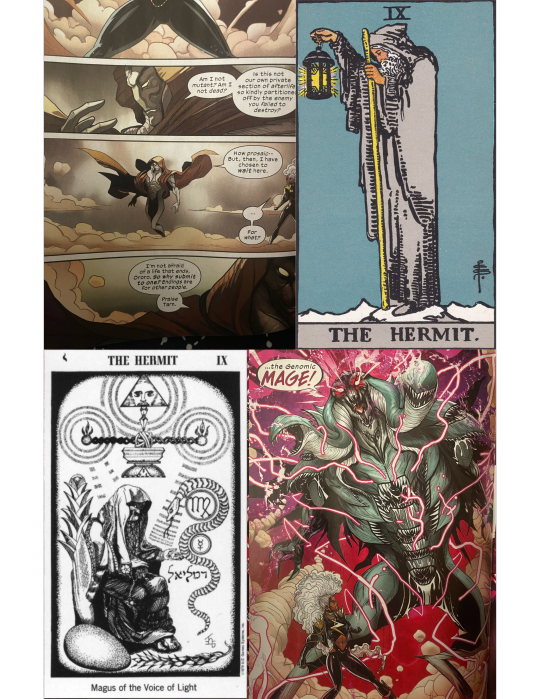
Tarn as the Hermit (or maybe the Devil but I’m leaning Hermit due to the serpent imagery)

The 7 of Cups featuring the Wheel of Fortune

Ashake, servant of the goddess Ma’at, as Adjustment (Justice), but the black cat and magical attributes are also giving Queen of Wands
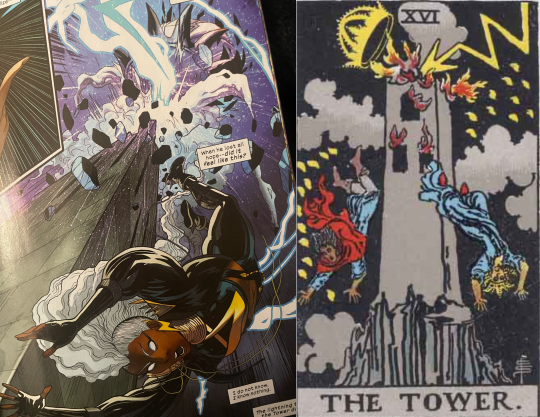
Storm as the Tower

The Domains as the Sun in Domain Space (Hod) peeking into Beyonder Space (Yesod)

Storm and Magneto as the Hanged Man

Storm as the 5 of Swords, featuring elements of the 5 of Cups, in the Broken City (Gavurah)
#comics are good for your soul#tarot#marvel#kabbalah#comics#x-men#Storm#Magneto#tarn#ashake#ma’at#5 of cups#5 of swords#7 of cups#The hermit#wheel of fortune#the tower#the hanged man#adjustment#justice#the sun#gavurah#netzach#hod#yesod#thoth tarot#hermetic tarot#ororo munroe#nathaniel essex#resurrection of magneto
18 notes
·
View notes
Text

All hail the goddess Maat, the literal embodiment truth and justice itself!
𓁧
#history#ma’at#ancient egypt#maat#order#ancient history#justice#feather of maat#mythology#kemetism#ancient egyptian history#goddess#myths#egyptology#egyptian mythology#ancient egyptians#womens history#divine#ancient#kemetic#egyptian goddess#mythological history#laws#nickys facts
6 notes
·
View notes
Text

drew mom ma’at as practice, she’s good enough to post here, dua ma’at
#egyptian paganism#kemetism#ma’at#bonus djehuty bc i love him even if he torments my dreams#egyptian mythology#reimu vibes.
22 notes
·
View notes
Text
The Philosophy of Ma’at
The philosophy of Ma’at originates from ancient Egyptian thought and represents the foundational principle of cosmic order, truth, justice, harmony, balance, and morality. Ma’at is both a goddess and a concept, symbolizing the natural law that governs the universe, society, and individual behavior. It played a central role in the ethics, politics, and religious life of ancient Egypt.
Key Principles of Ma’at
Cosmic Order and Harmony:
Ma’at embodies the natural order of the universe, ensuring that all elements of the world—both physical and metaphysical—exist in balanced harmony. This includes the movement of the stars, the cycles of nature, and human relationships.
Ma’at is the force that counters Isfet, or chaos. Maintaining Ma’at was essential to preserving the stability of the world and preventing the descent into disorder.
Truth and Justice:
Ma’at represents truth in both a literal and moral sense. To live in accordance with Ma’at is to live truthfully, embracing honesty, fairness, and justice.
In Egyptian society, kings (Pharaohs) were expected to rule according to Ma’at, ensuring justice in legal, social, and political matters. Judges and officials invoked Ma’at when making decisions, as justice was seen as a reflection of cosmic balance.
Moral and Ethical Conduct:
Living according to Ma’at involved a commitment to ethical behavior. This included virtues such as truthfulness, integrity, generosity, respect, humility, and compassion.
Individuals were expected to contribute to societal harmony by acting justly and in alignment with the community’s well-being. This included respect for family, honoring ancestors, and maintaining relationships based on mutual fairness and kindness.
Ritual and Religious Practice:
Ma’at was not just an abstract concept but also a goddess worshipped in temples and daily rituals. Pharaohs, as the earthly representatives of Ma’at, were tasked with performing rituals to ensure the continued balance between the gods, nature, and humanity.
Offerings and prayers to Ma’at were meant to maintain cosmic balance, ensuring favorable outcomes such as good harvests, protection from natural disasters, and societal peace.
Ma’at and the Afterlife:
In the afterlife, Ma’at played a key role in the judgment of souls. The Weighing of the Heart ceremony, described in the Book of the Dead, involved weighing a deceased person's heart against the feather of Ma’at. If the heart was lighter than the feather, the soul was deemed virtuous and granted access to the afterlife.
The symbolism of the feather represents purity, truth, and justice. If the heart was heavier, symbolizing a life of sin or imbalance, the soul would be devoured by Ammit, a creature representing annihilation.
Ma’at and Leadership:
Pharaohs were seen as upholders of Ma’at, both politically and religiously. Their rule was considered legitimate only as long as they maintained Ma’at, and their primary duty was to ensure justice, harmony, and the protection of their people from chaos (Isfet).
The king's role in upholding Ma’at was intertwined with religious duties, as they performed daily rituals to reaffirm the relationship between the gods and society.
Social and Environmental Responsibility:
Ma’at also extended to one’s responsibilities toward society and the environment. People were expected to contribute to the common good, maintain peaceful relationships, and live sustainably within the natural world.
Protecting the environment, fostering communal welfare, and adhering to one’s duties were seen as necessary to uphold Ma’at. Individuals who deviated from this path contributed to the breakdown of order.
Opposition to Isfet (Chaos):
Isfet, the opposite of Ma’at, represents disorder, injustice, falsehood, and destruction. Ancient Egyptians believed that the constant struggle between Ma’at and Isfet was inherent in the functioning of the cosmos.
Upholding Ma’at was a daily battle against Isfet. Actions like dishonesty, oppression, and violence were manifestations of Isfet and had to be resisted to preserve balance in society and the natural world.
The philosophy of Ma’at emphasizes the importance of balance, justice, truth, and harmony in all aspects of life—individual, social, and cosmic. It serves as a framework for ethical living, responsible leadership, and societal well-being, promoting a worldview in which all elements of existence are interconnected and must be in balance to sustain order and prevent chaos.
#philosophy#epistemology#knowledge#learning#education#chatgpt#ontology#metaphysics#Ma’at#Egyptian Philosophy#Truth and Justice#Cosmic Order#Ethical Conduct#Afterlife and Judgment#Isfet and Chaos#Pharaoh and Leadership#Ancient Egyptian Religion
3 notes
·
View notes
Text
I’ve been doing more work with Kemeticism lately and it makes me so happy. Honoring Ma’at feels as natural as breathing, it feels like I finally have a name for this thing I’ve believed in all my life. I also believe I will be going to the Egyptian afterlife and nothing brings me more peace and happiness.
3 notes
·
View notes
Text
the prerogative of the privileged is to share with and provide for those who have not been so fortunate. those who have never been denied ought not to deny him who would ask for help.
as a devotee and child of Ra, i look to the aspect of Him which is infinitely provident, who “provideth bread for all,” who “made every man like his fellow,” and who comes to those who call. my offerings of Ma’at to Him take the form of my mutual aid efforts and humanizing those who have been pushed into the shadow of the city i live in. Ma’at is an active and practical principle that flourishes when embodied in our day-to-day interpersonal interactions.
30 notes
·
View notes
Text
Em hotep!
It is a beautiful day to uphold Ma’at!!
#kemetic#witchblr#witchcraft#witch#kemetic pantheon#kemetic witch#kemetic paganism#Dua Ma’at#ma’at#Netjeru
23 notes
·
View notes
Text
MA’AT

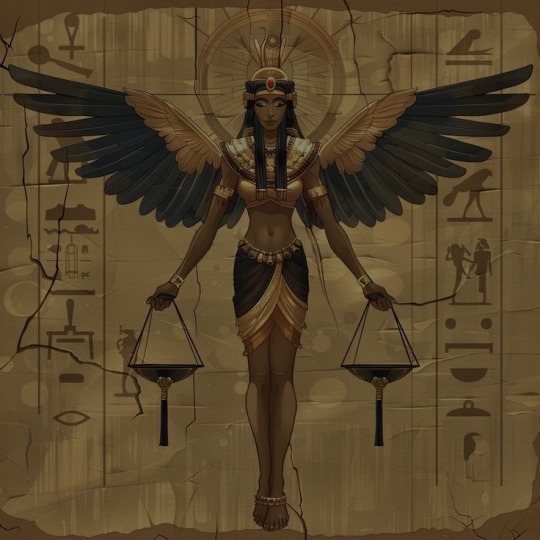

WHO IS SHE?
Maat or Maʽat comprised the ancient Egyptian concepts of truth, balance, order, harmony, law, morality, and justice. Ma'at was also the goddess who personified these concepts, and regulated the stars, seasons, and the actions of mortals and the deities who had brought order from chaos at the moment of creation.
BASIC INFO:
Appearance: a woman who is either sitting or standing with an ostrich feather on her head and, in some cases, she was depicted with wings.
Personality: she is often depicted as maintaining the cosmic order and preventing chaos. In some depictions, she is shown as a stern and fearsome deity, punishing those who go against her principles.
Symbols: scales, ostrich feathers, and Ankh
Goddess of: truth, justice, cosmic order, harmony, wisdom, morality, and balance
Culture: Egyptian
Plants and trees: papyrus, orris root, frankincense, aloe, lotus, and rose
Crystals: jade, turquoise, clear quartz, and blue calcite
Animals: vulture and ostrich
Incense: frankincense, rose, and myrrh
Practices: balance magick, cleansing, healing, and divination
Colours: white, gold, blue, and green
Numbers: 2, 7, and 8
Zodiac: Libra
Tarot: Justice, Temperance, and Judgment
Planets: Mercury
Days: Wednesday, Yule, new moon, New Years, and Opet
Parents: Ra and Hathor
Sibling: Shu
Partner: Thoth
Children: Seshat
MISC:
Ostrich feathers: represented truth and justice, as a symbol of Ma'at's role as the goddess of these principles.
Ankh: life and the breath of life, as the Egyptians believed Ma'at was responsible for the cycle of life and death.
Scale: justice and balance, as the instrument used to weigh the heart of the deceased against her feather.
Papyrus: truth and knowledge, as it was a common writing material and symbol of written records.
Eye of Horus: healing and protection, as Horus was the god of the sky and healing, and the eye of Horus was a symbol of health and regeneration.
Sceptre: she was believed to wield the authority to maintain the cosmic order and ensure that truth and justice prevailed in the world. The sceptre symbolised her power and authority as the goddess of truth and justice.
Lotus flower: rebirth and renewal, as the lotus would emerge from the mud and bloom each day.
FACTS ABOUT MA’AT:
Ma'at was believed to sit at the scales during the weighing of the heart, determining of the deceased was worthy of the afterlife.
She originally determined the daily course of the sun.
Ma'at was the counterpart and balance to chaos, and it was her role to maintain the cosmic order and prevent chaos from winning over.
She was also associated with the Nile River, which was seen as the lifeblood of Egypt and a symbol of fertility and renewal.
In some accounts, Ma'at was seen as the mother of the Ennead, the nine creator gods of Egypt.
She was believed to weigh the heart of the deceased in the afterlife, along with the help of Anubis and Thoth.
HOW TO INVOKE MA’AT:
Meditate on her symbolism and the meaning of truth, justice, and order. Use divination tools like tarot or oracle cards to call upon her guidance in decision making, perform rituals or ceremonies centered around honesty and integrity in the self, use visualizations to connect with the energy of Ma'at, focusing on the qualities of balance, order, and truth. Incorporate crystals associated with Ma'at, like clear quartz, blue calcite, jade, and turquoise into your spiritual practice.
PRAYER FOR MA’AT:
Oh goddess Ma'at, you whom we celebrate and honor on this auspicious day. We call upon you, great goddess of truth, justice, and order. Hear our humble prayers and answer our supplications with grace, with your mighty scepter, bring balance to our souls and our lives.
Guiding us with your divine wisdom and protecting us from the traps of chaos and disorder. We offer praises and gratitude for your infinite goodness and wisdom, may your light always illuminate our path, Hail Lady Ma’at.
SIGNS THAT MA’AT IS CALLING YOU:
Repeated thoughts or dreams of order, balance, and justice.
Unexpected opportunities to help others or uphold moral principles.
Feeling a strong connection to the number eight (representing the eight petals of the lotus and the eight elements of the soul).
Unexplained urges to study ancient Egypt or its mythology.
Encountering symbols associated with Ma'at (such as a feather, a scale, or a lotus flower) frequently.
A feeling of a guiding presence or inner voice that encourages you to seek truth and uphold justice.
Being attracted to the colour blue.
Increased intuition and a sense of empathy for the suffering of others, as Ma'at represents the compassionate aspect of justice.
Sudden encounters with people or situations that prompt you to defend truth and fairness.
Synchronicities or divine signs that relate to the justice system, such as dreaming of a courtroom or witnessing an injustice.
Deep desire for truth and honesty in all aspects of your life, leading to more authentic relationships and decisions.
A growing desire to be of service to others and stand up for the rights of the oppressed, reflecting Ma'at's role as a defender of the weak.
OFFERINGS:
No drugs and alcohol.
Cold water.
Bread.
Tea with milk.
Dates.
Plums.
Fish.
Chicken.
Olive oil.
Vinegar.
Books or scrolls.
Hummus.
Barley biscuits.
Reeds.
Gold jewelry.
White linen.
Grains.
Flowers and plants that symbolize growth, renewal, and abundance.
Mirrors.
DEVOTIONAL ACTS:
Daily meditation on her symbolism and the principles she represents, such as truth, justice, and order.
Recitation of prayers, chants, or invocations to Ma’at.
Performing daily acts of justice and truthfulness.
Practicing honesty and integrity in all your relationships and interactions.
Participating in social justice causes and promoting equality and fairness in society.
Setting up a shrine or altar dedicated to Ma'at, with symbols of her such as a feather, scepter, or scale.
Regularly reading or studying texts on Ma'at's mythology and symbolism.
Practicing self-reflection and introspection, examining your own moral compass and making efforts to align yourself with Ma'at's principles.
Making charitable donations or offering acts of kindness to those in need, as Ma'at is associated with compassion and benevolence.
Exploring ancient Egyptian practices associated with Ma'at, such as the ritual of the weighing of the heart or the performance of the Opening of the Mouth ceremony.
Embracing the divine feminine energy of Ma'at through dance or movement.
#fyp#fypシ#fypシ゚viral#fypage#fyppage#tumblr fyp#witchcraft#witches#witch community#deity#deity work#ma’at#maat#egyptian mythology#ancient egypt#information#masterlist#themortuarywitch
33 notes
·
View notes
Text
42 Ideals of Ma’at
1. I honor virtue
2. I benefit with gratitude
3. I am peaceful
4. I respect the property of others
5. I affirm that all life is sacred
6. I give offerings that are genuine
7. I live in truth
8. I regard all alters with respect
9. I speak with sincerity
10. I consume only my fair share
11. I offer words of good intent
12. I relate in peace
13. I honor animals with reverence
14. I can be trusted
15. I care for the earth
16. I keep my own counsel
17. I speak positively of others
18. I remain in balance with my emotions
19. I am trusted in my relationship
20. I hold purity and high esteem
21. I spread joy
22. I do the best I can
23. I communicate with compassion
24. I listen to opposing opinions
25. I create harmony
26. I invoke laughter
27. I am open to love in various forms
28. I am forgiving
29. I am kind
30. I act respectively of others
31. I am accepting
32. I follow my inner guidance
33. I converse with awareness
34. I do good
35. I give blessings
36. I keep the waters pure
37. I speak with good intent
38. I praise the goddess and the guard
39. I am humble
40. I achieve with integrity
41. I advance through my own abilities
42. I embrace the all
4 notes
·
View notes